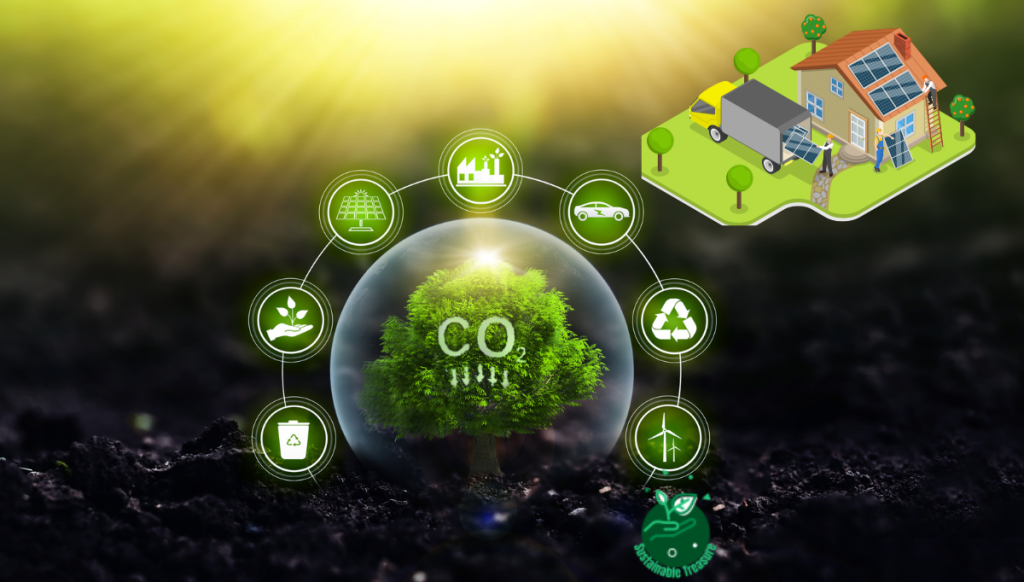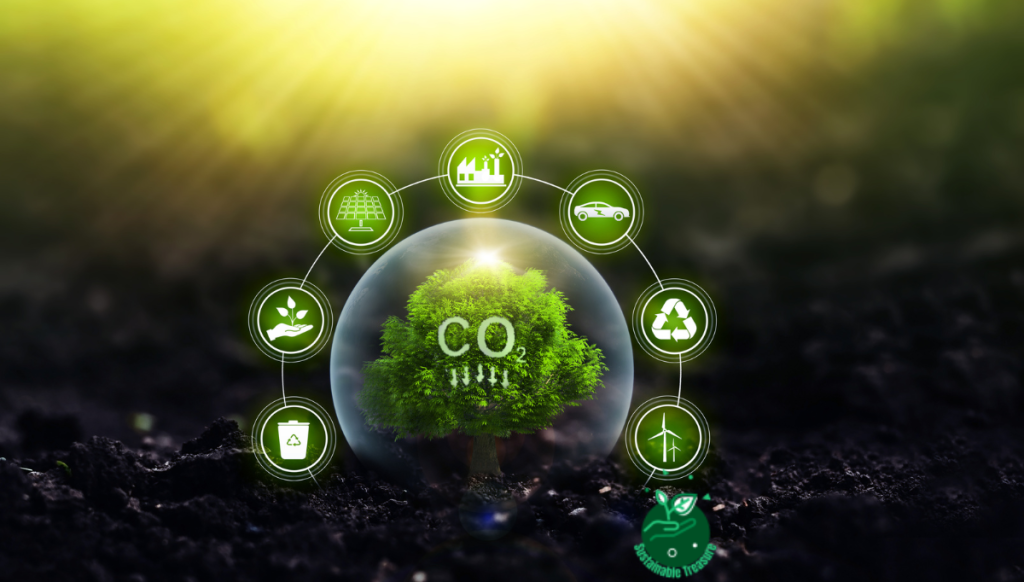Table of Contents
Are you wandering what Are Green Building Investments? Green building investments involve funding the development, construction, or acquisition of properties designed to minimize environmental impact and promote sustainability.
These eco-friendly structures prioritize energy and water efficiency, use of renewable materials, and improved indoor air quality.
Growing up, I witnessed my parents struggle with high utility bills and poor insulation in our drafty old home. The constant repairs and discomfort left a lasting impression on me.
Now, as an investor, I’m passionate about green buildings that slash operational costs while reducing our carbon footprint.
This comprehensive guide covers the essentials of green building investments so you can make informed decisions and how to get started.
What are Green Buildings?

Green buildings are designed, constructed, and operated to minimize negative environmental impacts and create healthier living spaces. Key aspects include:
- Energy Efficiency: Using techniques like extra insulation, efficient HVAC systems, and passive solar design to reduce energy consumption.
- Water Conservation: Incorporating low-flow fixtures, graywater recycling, and drought-resistant landscaping.
- Sustainable Materials: Utilizing renewable, recycled, and locally-sourced building materials when possible.
- Indoor Air Quality: Promoting adequate ventilation and minimizing toxic chemicals for better indoor air.
The benefits of green buildings are vast – lower utility costs, reduced greenhouse gas emissions, improved occupant health, and more. As demand grows, so do green building investment opportunities.
Why Invest in Green Buildings?
There are many compelling reasons to consider green building investments:
Financial Incentives
Federal, state, and local governments offer a range of incentives for green construction projects, such as tax credits, rebates, and grants. These can significantly improve return on investment.
Lower Operating Costs
Highly efficient green buildings use far less energy and water than conventional structures, resulting in much lower utility bills over the long-term.
Regulatory Compliance
Many locales are enacting stricter environmental regulations and building codes favoring sustainable design. Green investments help future-proof against these measures.
Market Demand
Both homebuyers and commercial tenants increasingly prefer green, energy-efficient spaces. Green buildings achieve higher occupancy rates and valuations.
Corporate Responsibility
For companies, sustainable investments demonstrate social and environmental responsibility, enhancing public image and investor relations.
Green Building Investment Options

So what are some of the top ways to invest in the green building boom? Let’s explore:
Green Construction Projects
Investing directly in the ground-up development of certified green residential or commercial buildings. Example:
| Project Type | Description | Risks |
|---|---|---|
| LEED Platinum Multi-Family | 120-unit apartment with solar, graywater reuse, green roof, EV chargers | Development delays, cost overruns, marketing challenges |
Green Building Materials
Supplying eco-friendly construction materials like bamboo, recycled plastic, and energy-efficient windows and insulation. Examples:
- Timber Block – Insulated log homes
- BlueSky Insulation – Recycled denim insulation
Green Retrofitting
Renovating existing buildings to improve energy performance through measures like weatherization, HVAC upgrades, and solar installations. Example:
| Renovation Type | Description | Projected Savings |
|---|---|---|
| Office Building Retrofit | New HVAC, LED lighting, low-flow fixtures | 30% annual energy/water reduction |
Green REITs
Investing in real estate investment trusts (REITs) focused on owning and operating environmentally sustainable properties. Examples:
- Green Realty Trust – Data centers powered by renewable energy
- Columbia Property Trust – Commercial buildings targeting LEED certifications
Cleantech Startups
Early-stage companies innovating in areas like solar tech, green HVAC systems, water recycling, and smart building materials. Example:
- AI-optimized design software to maximize energy efficiency
Green Funds
Mutual funds and ETFs comprised of stocks in sustainable construction, renewables, energy efficiency, and related sectors.
- Green Alpha Fund – Public equity in energy, transportation, water, green building, and agriculture
- SPDR S&P Kensho Clean Power ETF – Solar, wind, geothermal power
Risks of Green Building Investments
While the potential benefits are compelling, green investments carry some unique risks to consider:
Higher Upfront Costs
Green buildings typically involve higher initial construction and renovation expenses, offsetting future operational savings.
Technology Risks
Some green building solutions like new energy tech are still emerging, with uncertainties around long-term reliability and obsolescence.
Perceived vs. Actual Sustainability
Not all “green” projects deliver promised energy savings or environmental benefits in real-world use. Independent certifications like LEED matter.
Regulatory/Legislative Risks
Sustainability incentives and codes differ across jurisdictions and can change with political shifts, impacting project financials.
Market Cyclicality
Like any real estate market, green building can be susceptible to economic cycles and downturns in demand.
Renovation Challenges
Green retrofitting projects on existing structures can run into unforeseen issues like hazardous materials, structural limitations, and code violations.
All investments carry inherent risks, so careful due diligence on every green building opportunity is essential for mitigating potential pitfalls.
Getting Started with Green Investments
Ready to explore some sustainable investment options? Here’s a quick checklist to point you in the right direction:
- Educate yourself on green building techniques, standards, and certifications
- Consult financial professionals about incentives, tax implications, etc.
- Consider your investment timeline and risk tolerance carefully
- Evaluate the full lifecycle costs and returns of green projects
- Look for synergies tying environmental and economic sustainability
- Start small to gain experience before scaling up investment size
- Track measurable outcomes like energy usage and operational savings
With some preparation and sound strategy, green building investments can be both profitable and impactful for a sustainable future.
Key Takeaways
- Green buildings emphasize energy/water efficiency, sustainable materials, better indoor air
- Benefits include lower operating costs, regulatory compliance, market demand
- Green investment options: new construction, retrofits, REITs, materials, cleantech
- Consider risks like higher upfront costs, unproven technologies, market shifts
- Do diligent research, utilize incentives, track measurable performance
The green building revolution presents exciting opportunities for investors of all types. With thoughtful evaluation and expert guidance, you can tap into this dynamic, socially-conscious market while earning solid returns.
Go forth and build a greener, more sustainable portfolio! And check out our helpful green construction checklist for hands-on guidance.
FAQs

Why Should I Invest in Green Buildings?
There are several compelling reasons to consider green building investments. Firstly, these properties are designed to be highly energy and water efficient, resulting in significantly lower utility costs over their lifetime. This translates into improved cash flows and higher asset valuations.
Secondly, many governments offer financial incentives like tax credits, rebates, and grants to spur green construction. Taking advantage of these can boost your returns.
Furthermore, environmentally-conscious tenants and buyers increasingly favor sustainable buildings, ensuring strong occupancy rates and pricing power.
What Types of Green Buildings Can I Invest In?
The spectrum of green building investments is quite broad. You could invest in ground-up development projects like LEED-certified office buildings or net-zero energy homes.
Alternatively, consider acquiring and “greening” existing properties through retrofits like high-efficiency HVAC installation, solar paneling, etc.
Some investors prefer indirect plays like publicly-traded REITs focused on sustainable real estate assets. There are also opportunities in manufacturers of eco-friendly construction materials.
Cleantech startups pioneering smart home systems, insulation tech, and green design software offer venture capital potential.
Are Green Buildings Really More Valuable?
Numerous studies demonstrate premiums for certified green buildings in terms of rents, occupancy rates, asset pricing, and exit valuations versus their conventional counterparts. Higher-rated properties (e.g. LEED Platinum) command the largest “green” premiums.
However, the magnitude varies based on factors like location, asset class, energy prices, and market dynamics. Overall, tenants and investors are willing to pay a bit more for the lower operating costs and other benefits that green buildings deliver.
What Are Some Top Green Building Certifications?
When evaluating green investments, look for independent third-party certifications that validate environmental claims. The most prevalent rating system in the U.S. is LEED (Leadership in Energy and Environmental Design), overseen by the U.S. Green Building Council.
Other key certifications include the EPA’s Energy Star for operational efficiency, Green Globes for sustainable attributes, and zero-energy/zero-carbon standards like the Living Building Challenge. Credible “green” designations help derisk investments.
How Do I Find Incentives for Green Building Projects?
Incentives for green construction vary widely based on your location. At the federal level, the Residential Renewable Energy Tax Credit covers solar installations. Many states and municipalities layer on their own rebates, grants, density bonuses, and other incentives.
The DSIRE database is an excellent resource for identifying all applicable programs by zip code. Local economic development agencies can also advise on green building incentives within their jurisdictions. An experienced consultant can help maximize your qualified incentives.
What Due Diligence Steps Are Involved?
Rigorous due diligence is critical for any green investment analysis. This includes technical assessments from architects/engineers to validate energy models, sustainable material specifications, water usage calculations, and more. Projected utility cost savings must be realistic.
Develop a solid grasp of regulatory risks, zoning considerations, and construction costs specific to the project location.
Always procure insurance against development delays, material overruns, and other contingencies. Life cycle cost analyses are vital for anticipating lifetime expenditures.
What Are Some Top Green Building Investment Risks?
While green buildings offer attractive benefits, they also present some unique risks. One is that sustainable materials and technologies like solar can involve higher upfront costs before operational savings kick in. Some systems may lack proven long-term performance data.
Regulatory uncertainty regarding energy codes and incentives poses risks if policies shift. Market absorption challenges could occur if green premiums outpace tenant demand. With retrofits, hazards like mold, asbestos, and structural issues often lurk. Diligent risk management is key.
Where Can I Find Green Investment Opportunities?
Start by researching local developers with green building experience and lenders offering sustainability-geared financing products. Many real estate crowdfunding platforms highlight eco-friendly investment opportunities as well.
For public market exposure, investigate REITs, ETFs, and mutual funds with environmental/social/governance (ESG) investment mandates. Connect with green building associations like the U.S. Green Building Council to expand your network and deal pipeline.
Conclusion
To recap, green building investments span opportunities in eco-friendly construction projects, sustainable materials, property retrofits, REITs, cleantech ventures, and more.
Key benefits include lower operating expenses, tax incentives, regulatory compliance, and market demand.
Remember to thoroughly evaluate upfront costs, emerging technologies, and regulatory risks.
But with diligent planning, these investments can generate attractive returns while driving positive environmental impact.
The future is green buildings – get involved today! Connect with local developers, research incentives and certifications, and explore ways to align your portfolio with sustainable real estate.



